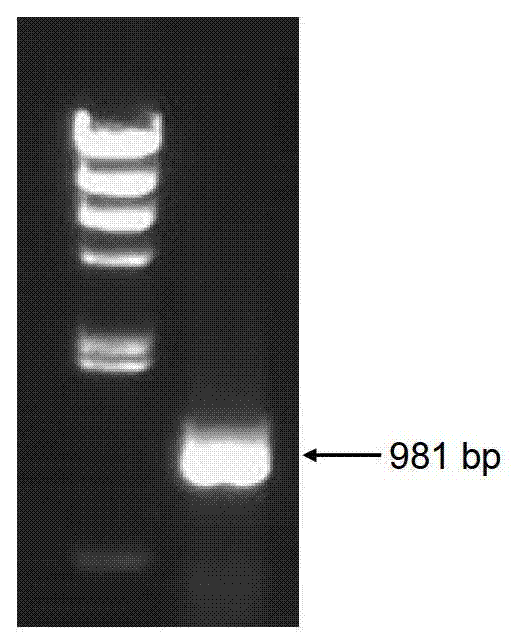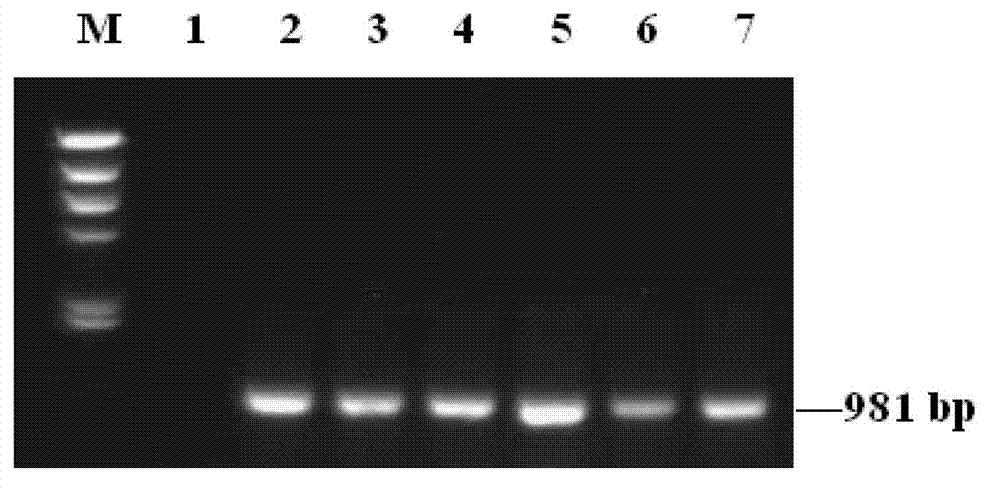Transgenic euramerican populus trichocarpa*populus deltoides for resisting apocheima cinerarius pests
A transgenic, poplar inchworm technology, applied in genetic engineering, plant genetic improvement, angiosperms/flowering plants, etc., to achieve the effects of reducing pesticide use, delaying pest resistance, and improving insect resistance
- Summary
- Abstract
- Description
- Claims
- Application Information
AI Technical Summary
Problems solved by technology
Method used
Image
Examples
Embodiment 1
[0022] Embodiment 1: the acquisition of transgenic hybrid poplar
[0023] 1. Cloning of wound response protein gene cDNA of hybrid poplar (Populus trichocarpa female parent×Populus del toides male parent)
[0024] According to the partial cDNA sequence (L20233.1) of the hybrid poplar (Populus trichocarpa×Populus deltoides) wound response protein registered in Genbank, primers were designed, using the total RNA of hybrid poplar (Populus trichocarpa×Populus deltoides) leaves as a template, with Forward:5' -atgtcgagcgttaacttggtag-3'; (SEQ ID No.2) and Reverse:5'-tcattcacaagccaaacgtg-3'; (SEQ ID No.3) are upstream and downstream primers, and a specific band of the expected size is obtained by RT-PCR ( The nucleotide sequence represented by SEQ IDNo.1), the result is as follows figure 1 shown.
[0025] The PCR product (nucleotide sequence represented by SEQ ID No.1) was recovered from the gel, and the recovered PCR product was ligated to the pJET1.2 vector, and the ligated produc...
Embodiment 2
[0041] Example 2: Insect resistance of a transgenic European and American hybrid poplar (transgenic hybrid poplar) resistant to poplar inchworm pests to poplar inchworm pests
[0042] Capability research
[0043] 1. Group breeding of poplar inchworms
[0044] The egg masses of Populus deltoides×Populus nigra (control plant) were used to hatch the egg masses of Populus deltoides×Populus nigra (control plants) and put the newly hatched 1st instar larvae of Populus deltoides in a clean and dry jar. Feed the larvae and tie the mouth of the bottle tightly with air-permeable gauze to ensure that the leaves are fresh and sufficient. There were 30 larvae per bottle, and 6 replicates were set. Place the culture bottle in a biochemical incubator at (25±2)°C and relative humidity (RH) 70%-80%. When feeding for 3 weeks, the body weight and body length of poplar inchworm larvae were counted for each treatment; the survival situation was counted before pupation, and the mortality rate wa...
PUM
 Login to View More
Login to View More Abstract
Description
Claims
Application Information
 Login to View More
Login to View More - R&D
- Intellectual Property
- Life Sciences
- Materials
- Tech Scout
- Unparalleled Data Quality
- Higher Quality Content
- 60% Fewer Hallucinations
Browse by: Latest US Patents, China's latest patents, Technical Efficacy Thesaurus, Application Domain, Technology Topic, Popular Technical Reports.
© 2025 PatSnap. All rights reserved.Legal|Privacy policy|Modern Slavery Act Transparency Statement|Sitemap|About US| Contact US: help@patsnap.com



